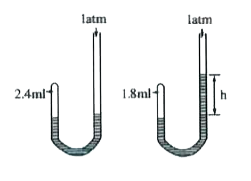In a constant volume gas thermometer, the pressure of the working gas is measured by the differenced in the levels of mercury in the two arms of a U-tube connected to the gas at one end. When the bulb is placed at the room temperature 27.00C, the mercury column in the arm open to atmosphere stands 5.00cm above the level of mercury in the other arm. When the bulb is placed in a hot liquid, the difference of mercury levels becomes 45..0Cm. Calculate the temperature of the liquid. (Atmospheric pressure =75.0cm of mercury).
The correct Answer is:A, C
To solve the problem step by step, we will use the relationship between pressure and temperature in a constant volume gas thermometer.
Step 1: Understand the relationship between pressure and temperature
In a constant volume gas thermometer, the pressure (P) of the gas is directly proportional to its temperature (T) in Kelvin. This can be expressed mathematically as:
P2P1=T2T1
Where:
- P1 is the pressure at room temperature.
- P2 is the pressure at the temperature of the hot liquid.
- T1 is the room temperature in Kelvin.
- T2 is the temperature of the hot liquid in Kelvin.
Step 2: Convert room temperature to Kelvin
The room temperature is given as 27.0∘C. To convert this to Kelvin:
T1=27+273=300K
Step 3: Calculate P1
At room temperature, the difference in mercury levels is 5.00cm. The atmospheric pressure is given as 75.0cm of mercury. Therefore, the total pressure P1 can be calculated as:
P1=Atmospheric Pressure+Difference in Mercury Level=75.0cm+5.0cm=80.0cmHg
Step 4: Calculate P2
When the bulb is placed in a hot liquid, the difference in mercury levels becomes 45.0cm. Thus, the pressure P2 is:
P2=Atmospheric Pressure+Difference in Mercury Level=75.0cm+45.0cm=120.0cmHg
Step 5: Use the relationship to find T2
Now we can use the relationship we established to find T2:
T2=P2P1×T1
Substituting the values we have:
T2=120.0cmHg80.0cmHg×300K
Step 6: Calculate T2
Calculating the fraction:
T2=12080×300=1.5×300=450K
Step 7: Convert T2 to Celsius
To convert the temperature back to Celsius:
T2(∘C)=T2(K)−273=450−273=177∘C
Final Answer
The temperature of the hot liquid is 177∘C.
---
In a constant volume gas thermometer, the pressure (P) of the gas is directly proportional to its temperature (T) in Kelvin. This can be expressed mathematically as:
P2P1=T2T1
Where:
- P1 is the pressure at room temperature.
- P2 is the pressure at the temperature of the hot liquid.
- T1 is the room temperature in Kelvin.
- T2 is the temperature of the hot liquid in Kelvin.
The room temperature is given as 27.0∘C. To convert this to Kelvin:
T1=27+273=300K
At room temperature, the difference in mercury levels is 5.00cm. The atmospheric pressure is given as 75.0cm of mercury. Therefore, the total pressure P1 can be calculated as:
P1=Atmospheric Pressure+Difference in Mercury Level=75.0cm+5.0cm=80.0cmHg
When the bulb is placed in a hot liquid, the difference in mercury levels becomes 45.0cm. Thus, the pressure P2 is:
P2=Atmospheric Pressure+Difference in Mercury Level=75.0cm+45.0cm=120.0cmHg
Now we can use the relationship we established to find T2:
T2=P2P1×T1
Substituting the values we have:
T2=120.0cmHg80.0cmHg×300K
Calculating the fraction:
T2=12080×300=1.5×300=450K
To convert the temperature back to Celsius:
T2(∘C)=T2(K)−273=450−273=177∘C
The temperature of the hot liquid is 177∘C.
Topper's Solved these Questions
- THERMOMETRY,THERMAL EXPANSION & KINETIC THEORY OF GASESBOOK - DC PANDEY ENGLISHCHAPTER - THERMOMETRY,THERMAL EXPANSION & KINETIC THEORY OF GASESEXERCISE - Level 2 Single Correct
12 Videos
- THERMOMETRY,THERMAL EXPANSION & KINETIC THEORY OF GASESBOOK - DC PANDEY ENGLISHCHAPTER - THERMOMETRY,THERMAL EXPANSION & KINETIC THEORY OF GASESEXERCISE - Level 2 More Than One Correct
7 Videos
- THERMOMETRY,THERMAL EXPANSION & KINETIC THEORY OF GASESBOOK - DC PANDEY ENGLISHCHAPTER - THERMOMETRY,THERMAL EXPANSION & KINETIC THEORY OF GASESEXERCISE - Level 1 Objective
10 Videos
- THERMOMETRY THERMAL EXPANSION AND KINETIC THEORY OF GASESBOOK - DC PANDEY ENGLISHCHAPTER - THERMOMETRY THERMAL EXPANSION AND KINETIC THEORY OF GASESEXERCISE - Medical entrance gallary
30 Videos
- UNIT AND DIMENSIONSBOOK - DC PANDEY ENGLISHCHAPTER - UNIT AND DIMENSIONSEXERCISE - Assertion And Reason
2 Videos
Similar Questions
The pressure of the gas in a constant volume gas thermometer is 80cm of mercury in melting ice at 1atm. When the bulb is placed in a liquid, the pressure becomes 160cm of mercury. Find the temperature of the liquid.
View SolutionThe pressure of the gas in a constant volume gas thermometer is 80cm of mercury in melting ice at 1atm. When the bulb is placed in a liquid, the pressure becomes 160cm of mercury. Find the temperature of the liquid.
View SolutionBy taking two J- tubes at constant temperature what is the difference in the levels of mercury in two columns ?

View SolutionIf 15.0 cm of water and spirit each are further poured into the respective arms of the tube, what is the difference in the levels of mercury in the two arms? (Relative density of mercury = 13.6).
View SolutionThe difference in the heights of mercury columns in a closed end manometer connected to a gas container is found to be 15 cm. What is the pressure of the gas in terms of Pa ?
View SolutionMercury thermometers can be used to measure temperatures upto
View SolutionExplain how is the height of mercury column in the tube of a simple barometer, a measure of the atmospheric pressure.
View SolutionThe pressures of the gas filled in the bulb of a constant volume gas thermometer are 66 cm and 88 cm of mercury column at 0∘C and 100∘C respectively. When its bulb is immersed in a liquid placed in a vessel, its pressure is 82.5 cm of mercury column. Calculate the temperature of the liquid.
View SolutionA manometer tube contains mercury of density 13.6×103 kg m−3. What difference in the levels of mercury in the two arms is indicated by a gauge pressure of 1.03×105Pa?
View SolutionA constant volume gas thermometer show pressure reading of 50cm and 99 cm of mercury at 0∘C and 100∘C respectively. When the pressure reading is 60 cm of mercury, the temperature is
View Solution
